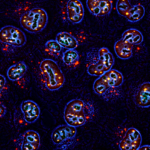Lien vers Pubmed [PMID] – 9427741
EMBO J. 1998 Jan;17(1):61-70
The PML protein, identified first as part of the oncogenic PML-RARalpha chimera in acute promyelocytic leukemia (APL), concentrates within discrete subnuclear structures, corresponding to some types of nuclear bodies. These structures are disrupted in APL cells, and retinoic acid (RA) can trigger their reorganization, correlating with its therapeutic effect in this type of leukemia. Recently, arsenic trioxide (As2O3) was identified as a potent antileukemic agent which, similarly to RA, induces complete remissions in APL patients. Here we show that, in APL cells, As2O3 triggers rapid degradation of PML-RARalpha and provokes the restoration of intact nuclear bodies. In non-APL cells, the ubiquitin-like protein SUMO-1 is covalently attached to a subset of wild-type PML in a reversible and phosphorylation-dependent manner. The unmodified form of PML is found in the soluble nucleoplasmic fraction, whereas the SUMO-1-polymodified forms of PML are compartmentalized exclusively in the PML nuclear bodies. As2O3 administration strikingly increases the pool of SUMO-1-PML conjugates that, subsequently, accumulate in enlarged nuclear bodies. In contrast to PML-RARalpha, the overall amount of PML seems to remain unaltered up to 36 h following As2O3 treatment. These findings indicate that the conjugation of PML with SUMO-1 modulates its intracellular localization and suggest that post-translational modification by SUMO-1 may be more generally involved than previously suspected in the targeting of proteins to distinct subcellular structures. They provide additional evidence that the role of ‘ubiquitin-like’ post-translational modification is not limited to a degradation signal.

